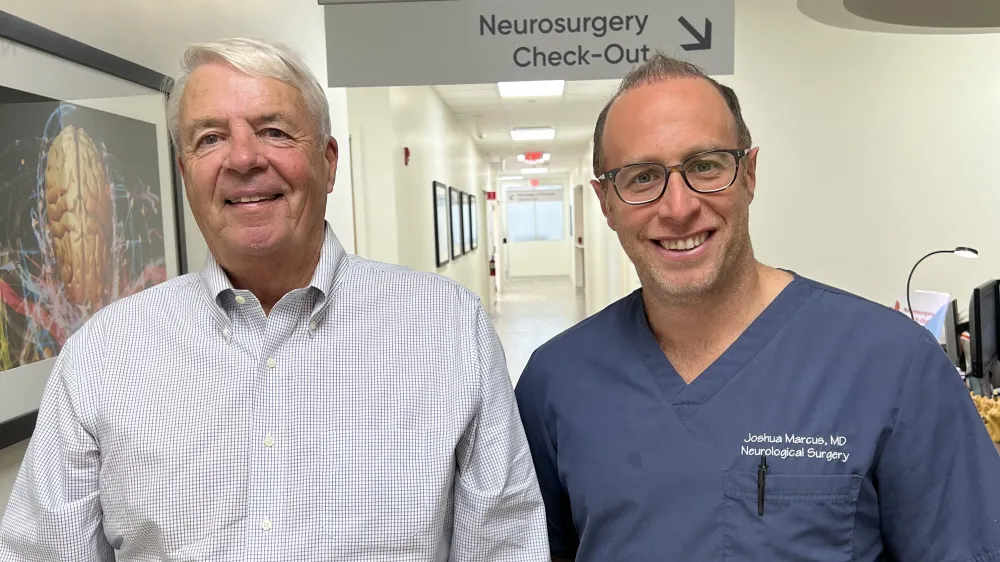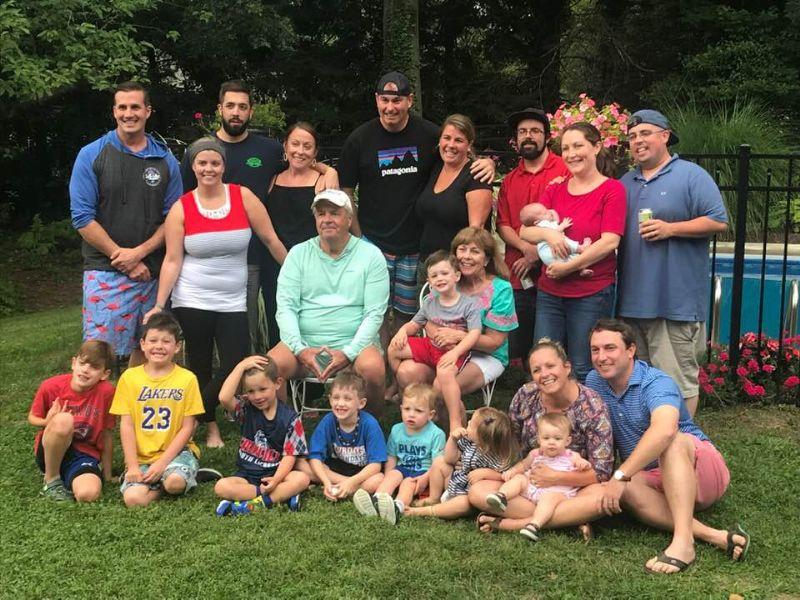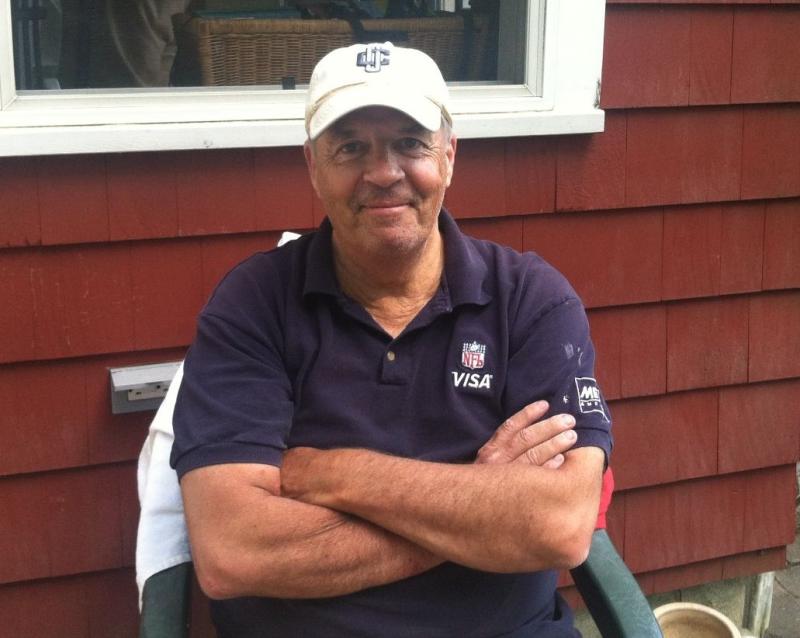Providing your location allows us to show you nearby locations and doctors.
From desperation to confidence: Connecticut man recovers after spine surgery for SDAVF

08/13/2025
After months of barely being able to walk, Gerard Keough found hope through advanced spine surgery at Norwalk Hospital for a rare spinal dural arteriovenous fistula.
When Gerard (Jerry) Keough and his wife visited the Peabody Museum last August, he suddenly couldn’t walk normally.
“My legs were suddenly giving out,” he said.
He ambled to the car and scheduled an appointment with his primary care provider. An MRI revealed the cause: a spinal dural arteriovenous fistula (SDAVF), an abnormal tangle of blood vessels on the protective covering of the spinal cord in his spine at L1 and L2 vertebrae.
Understanding spinal dural arteriovenous fistula
SDAVF is a rare vascular condition where arteries and veins connect abnormally in the dura, the outer layer surrounding the spinal cord. This vascular malformation can put venous pressure on the spinal cord and potentially damage it over time.
Symptoms often start with difficulty walking, weakness or numbness in the legs, and the condition can progress to serious neurological deficits if untreated. SDAVF occurs more frequently in men over 50, and the exact cause is often unknown.
As a self-proclaimed “news junky,” Jerry dove into research to understand his diagnosis.
“While I was fascinated with what I learned about SDAVF, it was unnerving to realize that I was the patient,” he said.
Related content: 5 ways to prepare to see a spine doctor for back or neck pain
Searching for the right spine surgery specialist
Jerry’s initial care team recommended follow-up imaging, but he hit multiple roadblocks scheduling the specialized tests he needed.
“The essential help I required to move forward ceased. I was left on my own to calculate and promote my future care, a huge obstacle for a lay person to navigate the challenging medical support landscape.
“I was dogged in my pursuit of an ally who understood my condition and could create a plan of action to remediate it, but was coming up empty,” he said.
On a Sunday afternoon, on a hunch, he found a Nuvance Health neurosurgery practice online and sent a message explaining his dilemma. To his surprise, Dr. Joshua Marcus, chief of neurosurgery at Norwalk Hospital, called him the next morning.
“I felt immediate relief,” Jerry said. “Dr. Marcus was interested in my case and familiar with the condition, even though I understood it to be rare. We talked about what would happen next step-by-step. For six months, I scrambled to find someone to guide me, take the reins and set the stage for my surgery and recovery. I felt so much relief that someone else was finally driving the bus, and I was in the front seat.”
Dr. Marcus and the neurosurgery team at Nuvance Health have extensive experience treating rare diseases. In fact, Dr. Marcus published a paper on SDAVFs in 2013.
Before the surgery, Jerry had a spinal angiogram so Dr. Marcus could map the arteries and veins supplying blood to the SDAVF. This mapping was critical to developing a successful plan to block the blood supply and fix the fistula.
During this procedure, Dr. Marcus guided a catheter through an artery in Jerry’s leg to the blood vessels surrounding his spine. Then, he took 3D images using a sophisticated biplane angiography system.
Advanced spine surgery at Norwalk Hospital
In March 2025, Jerry had spine surgery to fix the SDAVF.
“I was on a path to relief and resolution and felt very comfortable with Dr. Marcus’ surgical plan,” he said.
From the moment he arrived at Norwalk Hospital, now part of Northwell Health, Jerry noticed the welcoming environment.
“Norwalk Hospital was excellent: from the helpful security guard in the parking area, calm and welcoming reception staff to the supportive and kind preoperative nurses and anesthesiologist. I was going in for major spine surgery but felt at ease,” he said.
Dr. Marcus performed a laminectomy to relieve pressure on the spinal cord nerves and then disconnected the malformed arteries and veins.
Related content: What type of spine surgery is right for me?
After surgery, Jerry needed to have five days of strict bedrest, lying flat without moving his head or neck.
“Dr. Marcus prepared me for it, but it was tough,” Jerry said. “I was uncomfortable not being able to move for five days, but the caring staff made it better — I even enjoyed the meals.”
Compassionate care and a diverse team made the difference after major spine surgery
Jerry’s wife of 50 years, seven children and 10 grandchildren supported him throughout recovery. The hospital staff also left a lasting impression.
Outgoing and inquisitive, Jerry enjoyed learning about his care team’s diverse backgrounds — from Venezuela, Russia, Haiti, India, Jamaica, Ukraine and more.
“I commend Norwalk Hospital for finding these top-notch, impressive people,” he said. “It was uplifting to be surrounded by so many wonderful people with interesting backgrounds.”
He also praised the office team at the Nuvance Health Neuroscience Institute at iPark in Norwalk.
“Every time I called the office, I got a person and not a machine, and they always got me what I needed,” Jerry said.
Regaining mobility and moving forward after SDAVF surgery
After returning home, Jerry’s recovery was, in his words, “uneventful” — exactly what he hoped for.
“The major issues from before surgery were gone,” he said. “I didn’t have the catastrophic feeling of not being in control of my body anymore, which was a huge relief.”
During his recovery, Jerry had a follow up angiogram that confirmed the fistula was cured.
Walking was the key to recovery for Jerry. Within four months, he was walking four miles on the treadmill and doing leg and water exercises. He still has neuropathy (numbness and tingling) in his legs and feet, which Dr. Marcus had prepared him for, but he is expecting it will improve over time.
Jerry plans to retire soon and looks forward to resuming golf, pickleball, part-time work and volunteering.
Related content: How to recover from spine surgery
Advocating for yourself in the healthcare system
Jerry shared his experience to encourage others, especially seniors, not to give up.
“It’s important to know how to research your condition and find the appropriate doctor. Keep asking questions and searching for answers if you’re not getting what you need. Find a family member, friend or neighbor or the local senior center to help if you need it,” he said.
“I felt stonewalled and stymied with my initial care team. I was not making any headway until a light came on and I started advocating for myself,” Jerry said. “That’s when I found Dr. Marcus and went from desperation to confidence.
Dr. Marcus is a brilliant and intuitive neurosurgeon. On top of that, he has incredible compassion and dedication. I also appreciated how direct and honest he was. I have great admiration for him and his staff and thank them for giving me my life back.”
Dr. Marcus is a board-certified, fellowship-trained neurosurgeon with expertise in minimally invasive brain and spine surgery, and neurovascular surgery to treat brain aneurysm, strokes, arteriovenous malformations (AVMs) and SDAVFs. He is the chief of neurosurgery at Norwalk Hospital and chief of neurointerventional radiology at Danbury and Norwalk Hospitals. Book now with Dr. Marcus.
Hero image: (Left to right) Jerry Keough with neurosurgeon Dr. Joshua Marcus
The outcome of treatment for a SDAVF varies from person to person. No individual results should be seen as typical.

